Y’all gather ’round, sugar! It’s time to ditch the boxed mixes and whip up a batch of cornbread that’ll have your taste buds singin’ like a Southern choir on Sunday mornin’. We’re talkin’ about grandma’s secret recipe, passed down through generations, golden brown and fluffy as a summer cloud. Forget crumbly, dry disappointments – this cornbread’s got a buttery heart and a crispy edge that’ll make you wanna slap yo’ mama (figuratively speakin’, of course!). So grab your cast iron skillet, pour yourself a sweet tea, and get ready to bake up a taste of Southern tradition that’ll leave you sayin’, “Bless your biscuit-makin’ hands!”
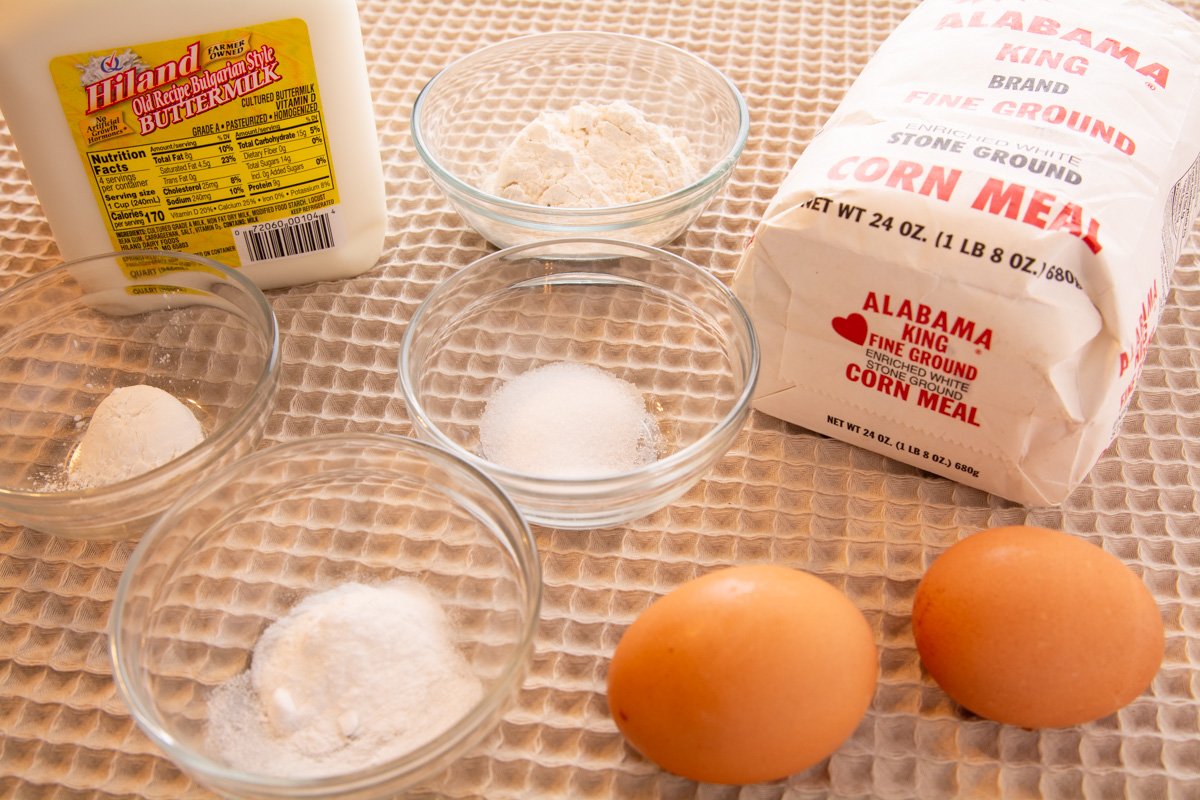
Cornbread Ingredients:
Cornmeal: You can use white or yellow cornmeal, depending on where you are from you may have a preference.
White Cornmeal:
- Flavor: Subtler, slightly sweet, lets other ingredients shine (like buttermilk or cheese).
- Texture: Lighter, fluffier crumb.
- Color: Golden brown crust, with the cornmeal flecks showing through.
- Classic Choice: Often preferred for traditional, savory cornbread, perfect for soppin’ up beans or chili.
Yellow Cornmeal:
- Flavor: More pronounced, richer corn flavor, with a hint of nuttiness.
- Texture: Denser, slightly moister crumb.
- Color: Deeper golden brown, with a more uniform color.
- Modern Twist: Adds a vibrant touch to cornbread, great for adding mix-ins like jalapenos or cheese.
Ultimately, the choice is yours! Some folks swear by white for its light bite and buttery goodness, while others love the deep corn flavor and dense crumb of yellow. Experiment with both and see which sings to your Southern soul! And hey, remember, there’s no wrong answer – just delicious cornbread waiting to be devoured!
Flour: Whether or not to use flour in cornbread is a debate as old as grits and gravy! Some folks swear by all-cornmeal cornbread for its intense corn flavor and crumbly texture, while others embrace the magic of flour for some key benefits:
1. Lighter & Fluffier Crumb: Adding flour strengthens the dough, giving it a lift and creating a lighter, airier crumb compared to all-cornmeal bread. This can be especially pleasant if you prefer a softer, more cake-like texture.
2. Tender Bites: Gluten in flour acts like glue, holding the cornmeal together and preventing it from being too crumbly. This results in more tender bites – perfect for slathering with butter or honey.
3. Structure & Stability: All-cornmeal batter can be a bit on the loose side, making it tricky to handle and bake. Flour adds structure and stability, ensuring your cornbread rises evenly and maintains its shape.
4. Browned Edges: Believe it or not, flour contributes to that crispy, golden-brown crust we all love! The combination of gluten and cornstarch in flour caramelizes beautifully, adding a satisfying crunch to every bite.
5. Versatile Variations: Adding flour opens up a world of possibilities! You can incorporate different types of flour (like whole wheat or rye) for added flavor and texture, or blend it with cornmeal for a unique balance.
So, while all-cornmeal cornbread has its devoted fans, using flour offers distinct advantages, from a fluffier crumb to a satisfying crust. Ultimately, the choice is yours! Experiment, discover what tickles your taste buds, and bake up a batch of cornbread that’s a love song to your own personal preferences. Just remember, no matter which side of the flour debate you’re on, there’s one thing we can all agree on – cornbread is pretty darn delicious!
Baking powder: The key to airy, light cornbread lies in trapped air bubbles. Baking powder, a little chemical magician, produces those bubbles by reacting with the liquid ingredients in your batter. As the baking powder fizzes, it releases carbon dioxide, getting trapped within the mixture and causing it to expand like a tiny hot air balloon. The result? A beautifully risen cornbread that’s far from dense and doughy.
Baking soda: Baking soda’s superpower lies in its chemical reaction. It doesn’t need baking powder’s BFF (acid) to activate, just good ol’ heat! This means it starts working its magic as soon as your cornbread hits the oven, creating bubbles alongside the baking powder to give your bread an extra lift. The result? A taller, airier cornbread that practically begs for a slathering of butter and honey.
Salt: Don’t be fooled by salt’s simple chemistry. It adds complexity and depth to the flavor profile of your cornbread. It balances the sweetness, cuts through any fattiness, and creates a well-rounded taste that keeps you coming back for more.
Eggs: Cornmeal on its own can be thirsty, leading to dry, crumbly cornbread. Enter the egg, with its yolk brimming with moisture and fat. It binds water into the batter, resulting in a moist, tender crumb that melts in your mouth with every bite. No more dry cornbread blues!
Buttermilk: Gluten in flour can make cornbread a bit dense. Buttermilk’s acidity comes to the rescue, gently breaking down gluten strands, resulting in a softer, more tender crumb. Every bite becomes a cloud of cornmeal heaven, begging for butter and honey.
Fat: Want a cornbread with a slightly denser, chewier texture? Fat (from oil, lard, or bacon grease) delivers! Unlike butter, which tends to create a more airy crumb, fat contributes to a slightly heavier bite that’s still perfectly tender. Perfect for those who like a bit more substance in their cornbread slices.
Sugar: Ah, the age-old Southern debate: sugar in cornbread? Both sides have their passionate followers, each singing the praises of their preferred style. Let’s dive into the sweet and savory worlds of cornbread, unraveling the mysteries of sugar’s role in this iconic dish. In this recipe, I did not use sugar but a little sugar can be tasty.
Sweet Tooth Swoon:
- Flavor Booster: A touch of sugar enhances the natural sweetness of cornmeal, creating a more balanced and palatable flavor. It can also complement other ingredients like honey, butter, or buttermilk, adding a delightful depth to each bite.
- Golden Glow: Sugar aids in browning, giving your cornbread a beautiful golden crust that’s crispy on the outside and fluffy on the inside. It’s an aesthetic touch that’s as pleasing to the eye as it is to the palate.
- Texture Twister: A small amount of sugar can contribute to a slightly softer, airier crumb in your cornbread. This creates a melt-in-your-mouth texture that some folks find particularly pleasurable.
Savory Soul Satisfaction:
- Cornmeal Symphony: Without sugar, the true corn flavor takes center stage. Some bakers appreciate the opportunity to savor the earthy, nutty notes of cornmeal unmasked by sweetness.
- Versatility Champion: Unsweetened cornbread pairs beautifully with savory dishes like chili, beans, or collard greens. It offers a neutral canvas to soak up flavorful sauces and stews, making it a perfect side dish partner.
- Healthy Choice: Ditching the sugar reduces the overall calorie count and carbohydrate content of your cornbread. This can be a welcome option for those watching their sugar intake or following a specific dietary plan.
Ultimately, the choice of whether or not to add sugar to your cornbread is a personal one. Explore both sides of the debate, experiment with different recipes and proportions, and discover what your own taste buds truly sing for! Remember, there’s no right or wrong answer – just delicious cornbread waiting to be baked, no matter your sugar preference.
How to make cornbread
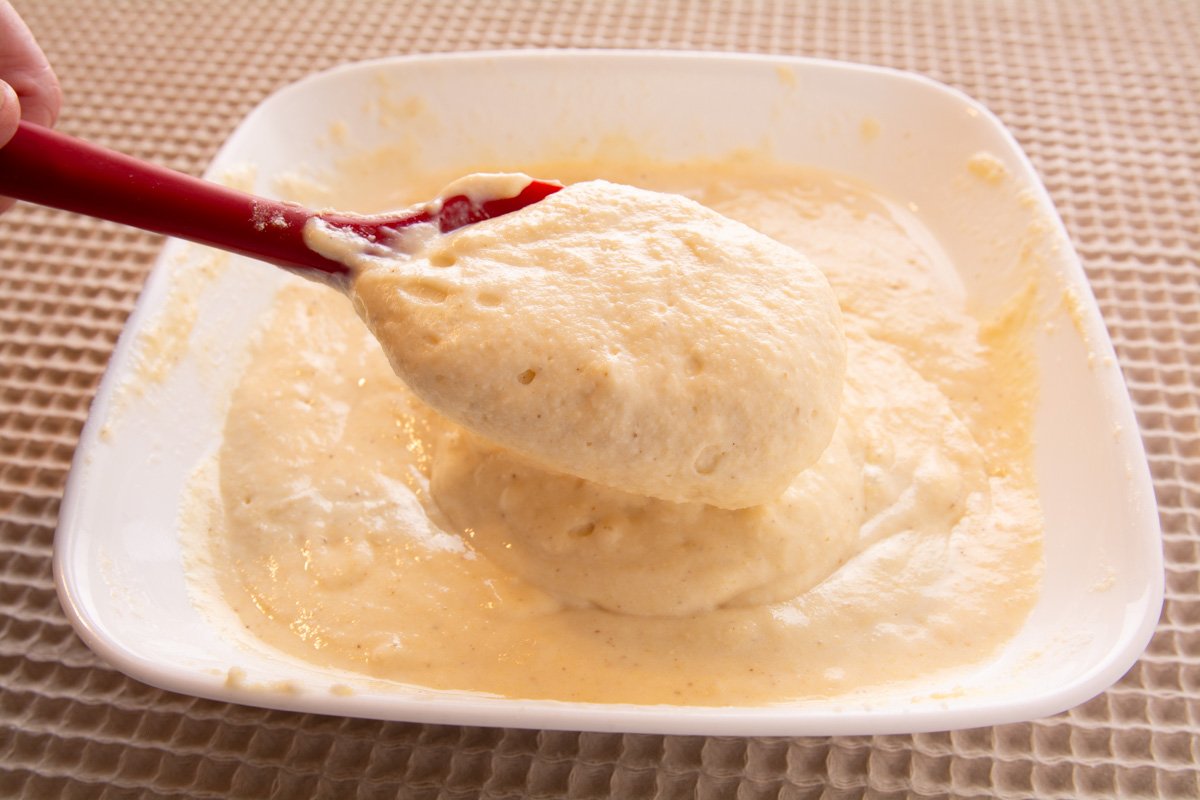
Okay, let’s get this cornbread party started! Grab your whisk and gather up your crew – cornmeal, flour, baking powder, baking soda, that salty sidekick, some eggs, tangy buttermilk, and two tablespoons of your oil squad (melted lard, vegetable oil, or even those leftover bacon drippings, if you’re feeling fancy!). Now, just give it a good stir-a-mundo until everything’s playing nice and there are no big lumps hanging out. Easy peasy, right?
P.S. Remember, don’t overmix! You want that batter nice and light, like a fluffy cloud ready to be transformed into cornbread magic.
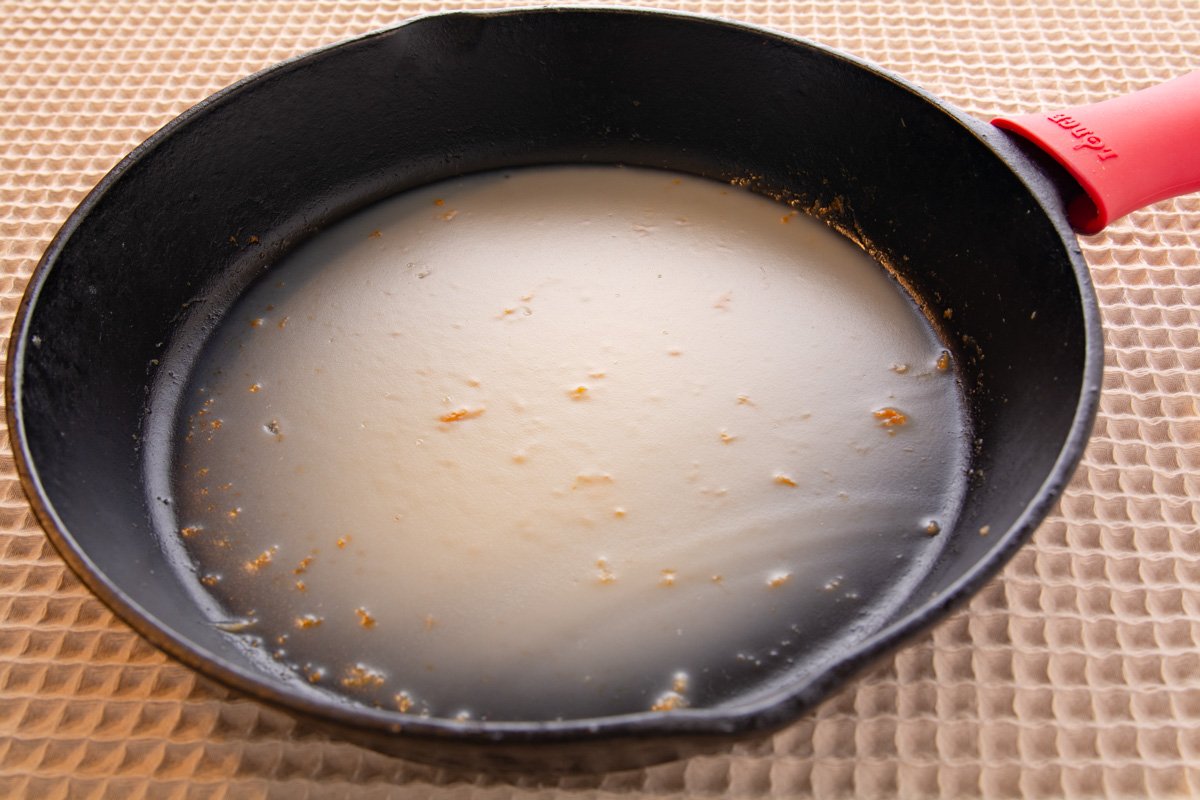
Those leftover bacon drippings from breakfast sound like they’re practically begging to be reborn as crunchy, salty magic in your cornbread. Cast iron is the champ for crust-tasty cornbread, but don’t worry if you haven’t got one nearby. Any trusty oven-safe dish will get you fluffy, delicious results. Just remember, with a cast iron skillet, you’re setting your cornbread up for success – imagine a golden, crispy bottom that sings a symphony of bacon-infused joy in every bite.
Crank your oven to 425°F and toss your trusty cast iron skillet inside until it just starts to smoke. Think of it as getting your pan nice and toasty for the batter party about to happen.
This is a delicious way to preheat your cast iron skillet for perfect cornbread! Remember, safety first when working with hot oil and ovens. Here are some tips to keep your baking adventure smooth and joyful:
- Watch the Smoke, Not the Clock: Instead of waiting for the grease to smoke, keep an eye on it for a slight shimmer and movement. That’s your cue to carefully remove the skillet from the oven. Smoking oil can be a fire hazard, so it’s best to err on the side of caution.
- Steady Hand, Hot Pan: Use potholders or oven mitts when handling the hot skillet. Cast iron retains heat incredibly well, so even after removing it from the oven, it can be pretty toasty.
- Sizzle & Safety: When adding the batter, be mindful of the hot oil. While the sizzle is satisfying, it can also mean splatters, so pour carefully at a safe distance.
- Puffy & Perfect: Once the batter hits the hot pan, those puffy edges are a great sign! It means the baking soda and powder are doing their magic, giving your cornbread lift and tenderness.
Cook your cornbread at 425°F until the top becomes a beautiful bronze masterpiece. Then grab your oven mitts (safety first!) and carefully usher your cornbread to a countertop safe haven. Give it a few minutes to cool down a bit, just enough to hold its shape, then grab a sharp knife and slice it into glorious triangles. Now, gather your spoons, slather on some butter or honey, and prepare to dive into fluffy cornbread bliss!
With these tips in mind, you’re all set to bake up a batch of golden, fluffy cornbread that’s sure to be a hit! Just remember, safety first, and then let the baking fun begin!
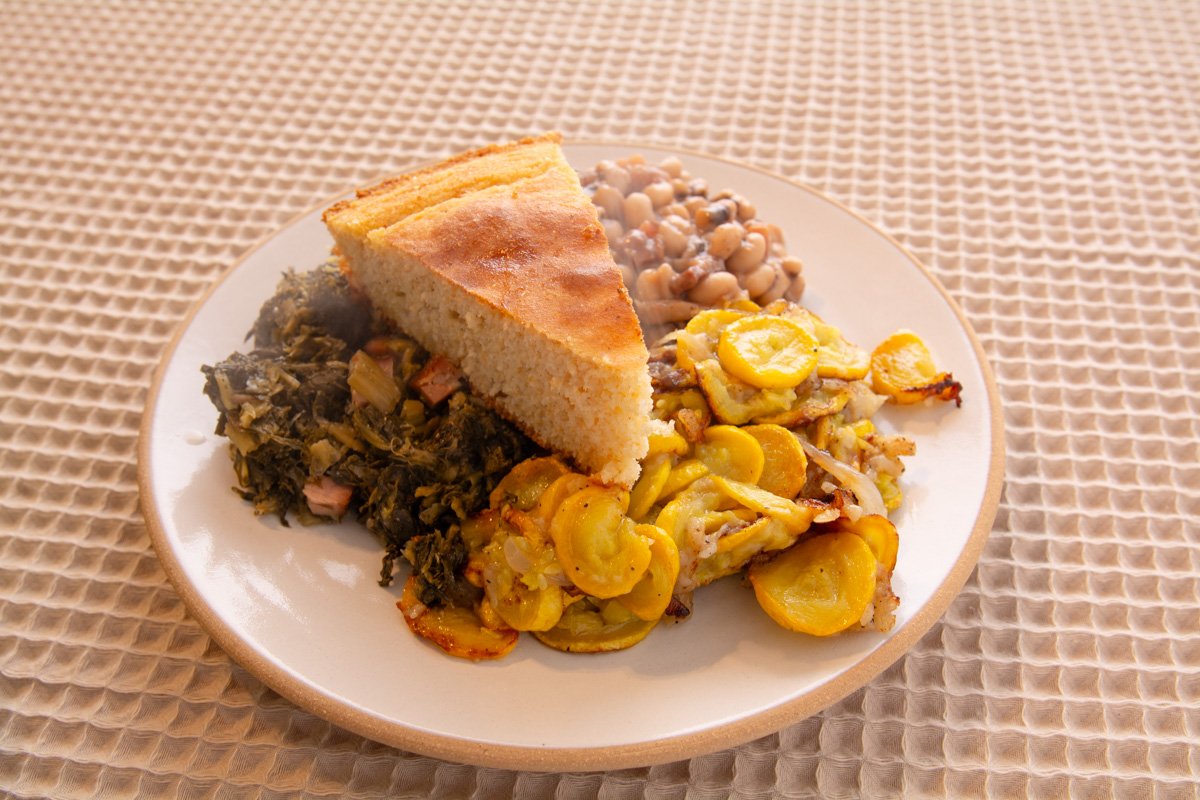
Cornbread and beans are a match made in Southern heaven. Whether it’s the creamy comfort of blackeyed peas or the hearty goodness of pinto beans, they find the perfect partner in the fluffy sweetness of cornbread. Each bite is a delicious dance of textures and flavors, a true celebration of Southern comfort food.
Here are some ways to amp up the pairing:
- Soak Up the Goodness: Use your cornbread as a sponge for those flavorful bean juices. Every morsel will be bursting with savory satisfaction.
- Crumble & Sprinkle: Crumble your cornbread over the top of your beans for a satisfying textural contrast. It’s like a crunchy, golden treasure hunt in every spoonful.
- Spoon & Swirl: Embrace the messy goodness! Top your beans with a generous dollop of butter or honey, then swirl it all together with a warm piece of cornbread. Pure bliss!
So next time you whip up a batch of cornbread, don’t forget the beans! They’re waiting to be your partner in a culinary adventure you won’t soon forget. https://jamesstrange.com/southern-crock-pot-pinto-beans-with-ham-hock-recipe-no-soak/
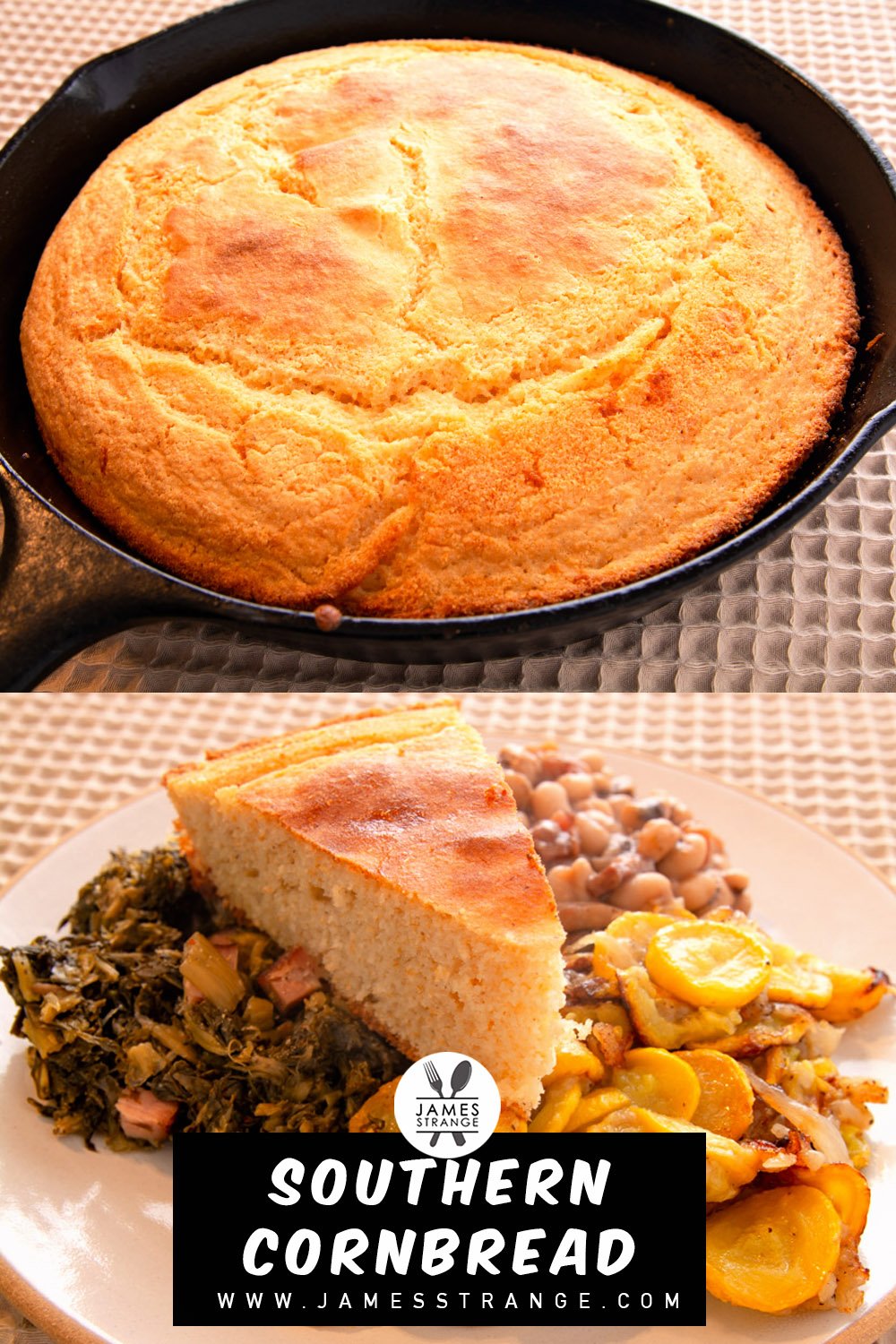
Spread the Cornbread Love! If you whipped up a batch of this deliciousness and it rocked your world, share the joy with your peeps on Facebook or Pinterest! It helps this little recipe haven grow and keep serving up Southern goodness to more folks like you.

Ingredients
- 2 Cups Cornmeal white or yellow
- 1/4 Cup All-purpose flour
- 1.5 teaspoons Salt
- 1 teaspoon baking powder
- 1 teaspoon baking soda
- 2 each eggs large, beaten
- 2.25 Cups Buttermilk
- 4 Tablespoons Oil Divided, can be lard, vegetable oil or bacon grease
Instructions
- Combine all of the ingredients (reserve 2 Tablespoons of oil for your skillet) in a large bowl and mix2 Cups Cornmeal, 1/4 Cup All-purpose flour, 1.5 teaspoons Salt, 1 teaspoon baking powder, 1 teaspoon baking soda, 2 each eggs, 2.25 Cups Buttermilk, 4 Tablespoons Oil
- Add 2 Tablespoons of oil to your skillet, place into your oven, and preheat to 425F.4 Tablespoons Oil
- When the oven is preheated remove the skillet from the oven and pour your batter into the hot skillet.
- Return the skillet to the oven and cook for 30 minutes, the top should be nice and brown.
- Remove from the oven and the cornbread is ready to serve.

Beware, the ratios are all off in this recipe. 2 1/4 cups of milk plus eggs and oil with only 2 1/4 cups of dry ingredients creates a wet soggy mix thinner than crepe batter.